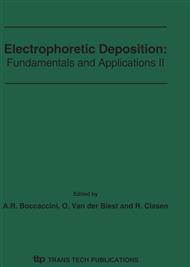p.213
p.219
p.225
p.231
p.237
p.245
p.251
p.257
p.263
Water Versus Acetone Electrophoretic Deposition of Hydroxyapatite on 316L Stainless Steel
Abstract:
Hydroxyapatite (HAP) was electrophoretically deposited on 316L stainless steel in order to promote a bioactive surface. The effect of dispersing media (water and acetone), applied voltage and the deposition time on the deposit weight and microstructure of the coatings was evaluated. The deposition time was varied in the range of 1 to 900 s for water suspensions and 0.5 to 180 s for acetone suspensions. Suspensions were prepared by using HAP powder with an average particle size of 1.5 μm at a concentration of 1 % by weight. The deposition was performed under a direct current (DC) field of 400 to 1000 V for acetone suspensions and 5 to 50 V for water suspensions. The coatings were analyzed using scanning electron microscopy. The amount of hydroxyapatite on the surface of the metallic substrate was evaluated by determining the difference in weight of the samples, before and after the electrophoretic process. The stabilization of HAP particles in water was achieved using 1 % by weight of Dispex N40TM and 0.001M KCl. Under this condition the zeta potential of HAP in water suspension was –28 mV. Non additive was required in acetone suspensions. Dense, homogeneous and crack-free coatings of sub-micron particles (0.63 mg/cm2) were obtained by applying 5 V during 60 s in water suspensions. Above a DC field of 5 V the hydrolysis of water seriously difficulties the coatings formation. Homogeneous and crack-free coatings of sub-micron particles (1.45 mg/cm2) were also obtained in acetone suspensions applying 400 to 1000 V during 5 s. Lower voltages were not used with acetone suspensions due to its high resistivity.
Info:
Periodical:
Pages:
237-244
Citation:
Online since:
July 2006
Price:
Сopyright:
© 2006 Trans Tech Publications Ltd. All Rights Reserved
Share:
Citation:


